Communication Strategy for Hospitality: An Annotated Bibliography
VerifiedAdded on 2023/04/12
|13
|2425
|329
Annotated Bibliography
AI Summary
This annotated bibliography evaluates ten different sources to develop a comprehensive communication strategy, including digital communications, for the hospitality industry, specifically focusing on JuJare Hotel. The sources cover various aspects of communication, including the use of social media as a marketing tool, how social media is changing crisis communication strategies, innovative technological proposals for improving communication and service quality, increasing purposeful communication in the workplace, factors of enterprise education communication, communication strategies used in tourism, workplace communication stories, the impact of ICTs in mass tourism destinations, stakeholder engagement as a communication design practice, and the impact of leader-follower communication styles. The analysis of these sources provides insights into developing and implementing effective communication strategies for organizations, particularly in the hospitality sector, emphasizing the importance of adapting to technological advancements and understanding stakeholder needs.
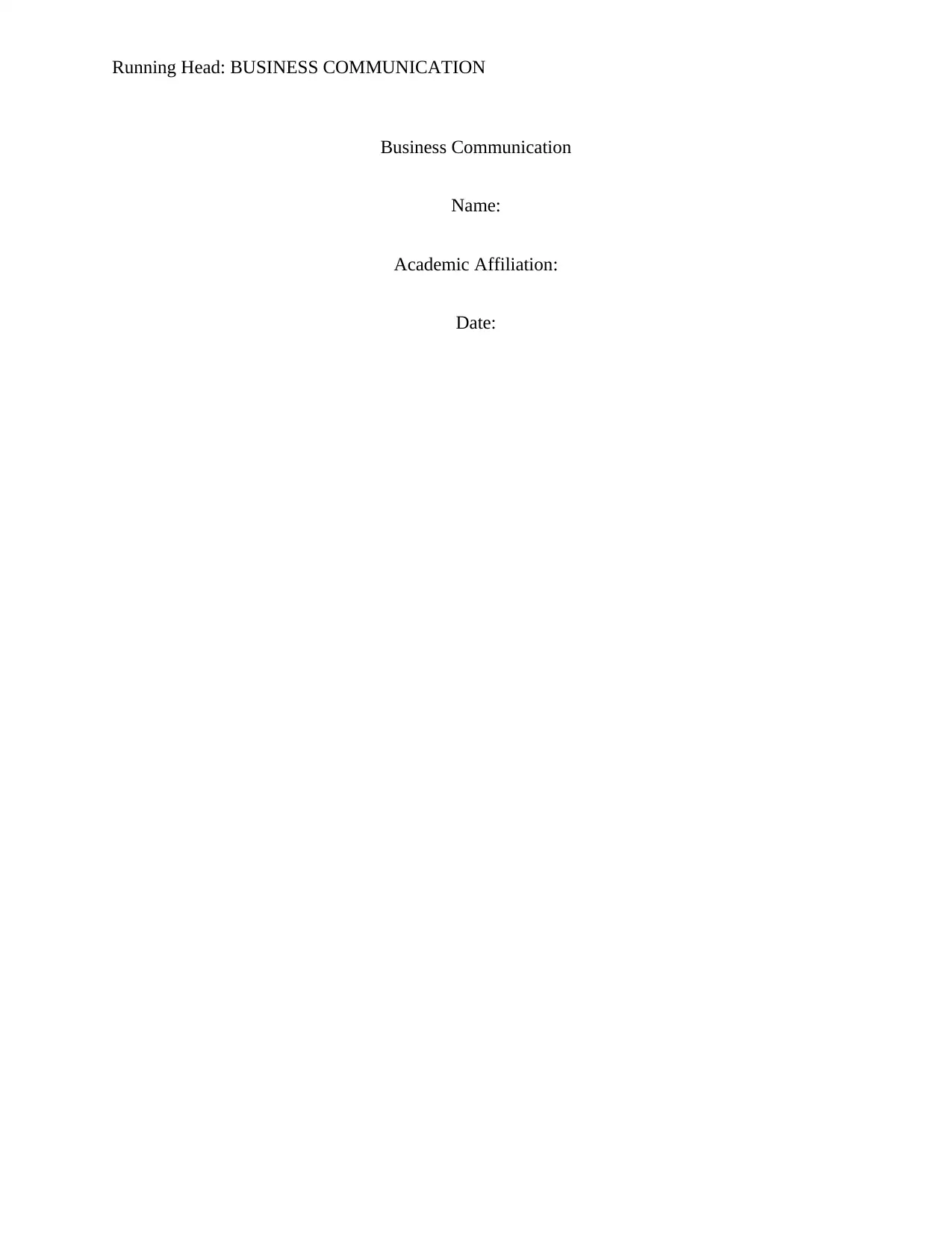
Running Head: BUSINESS COMMUNICATION
Business Communication
Name:
Academic Affiliation:
Date:
Business Communication
Name:
Academic Affiliation:
Date:
Paraphrase This Document
Need a fresh take? Get an instant paraphrase of this document with our AI Paraphraser
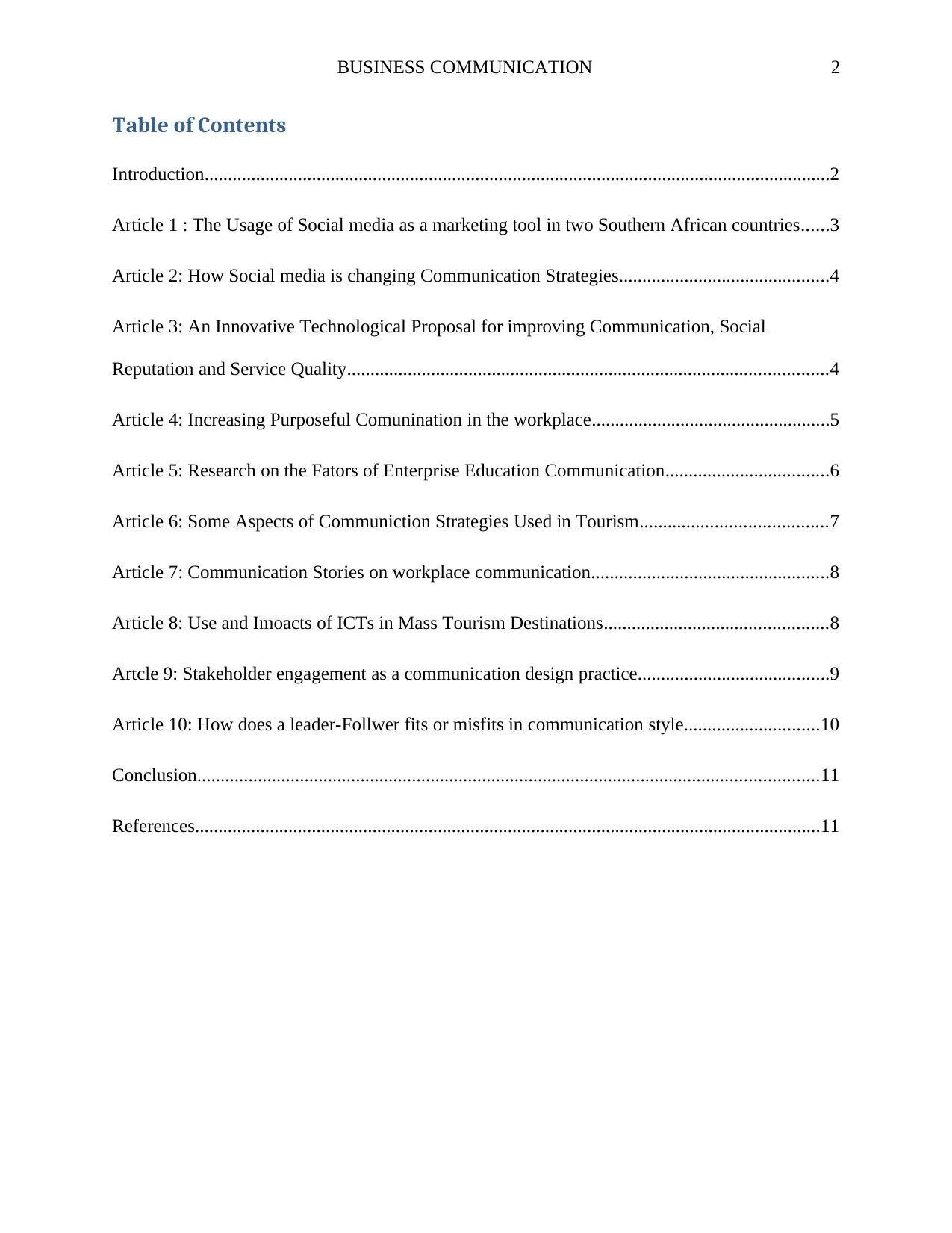
BUSINESS COMMUNICATION 2
Table of Contents
Introduction......................................................................................................................................2
Article 1 : The Usage of Social media as a marketing tool in two Southern African countries......3
Article 2: How Social media is changing Communication Strategies.............................................4
Article 3: An Innovative Technological Proposal for improving Communication, Social
Reputation and Service Quality.......................................................................................................4
Article 4: Increasing Purposeful Comunination in the workplace...................................................5
Article 5: Research on the Fators of Enterprise Education Communication...................................6
Article 6: Some Aspects of Communiction Strategies Used in Tourism........................................7
Article 7: Communication Stories on workplace communication...................................................8
Article 8: Use and Imoacts of ICTs in Mass Tourism Destinations................................................8
Artcle 9: Stakeholder engagement as a communication design practice.........................................9
Article 10: How does a leader-Follwer fits or misfits in communication style.............................10
Conclusion.....................................................................................................................................11
References......................................................................................................................................11
Table of Contents
Introduction......................................................................................................................................2
Article 1 : The Usage of Social media as a marketing tool in two Southern African countries......3
Article 2: How Social media is changing Communication Strategies.............................................4
Article 3: An Innovative Technological Proposal for improving Communication, Social
Reputation and Service Quality.......................................................................................................4
Article 4: Increasing Purposeful Comunination in the workplace...................................................5
Article 5: Research on the Fators of Enterprise Education Communication...................................6
Article 6: Some Aspects of Communiction Strategies Used in Tourism........................................7
Article 7: Communication Stories on workplace communication...................................................8
Article 8: Use and Imoacts of ICTs in Mass Tourism Destinations................................................8
Artcle 9: Stakeholder engagement as a communication design practice.........................................9
Article 10: How does a leader-Follwer fits or misfits in communication style.............................10
Conclusion.....................................................................................................................................11
References......................................................................................................................................11
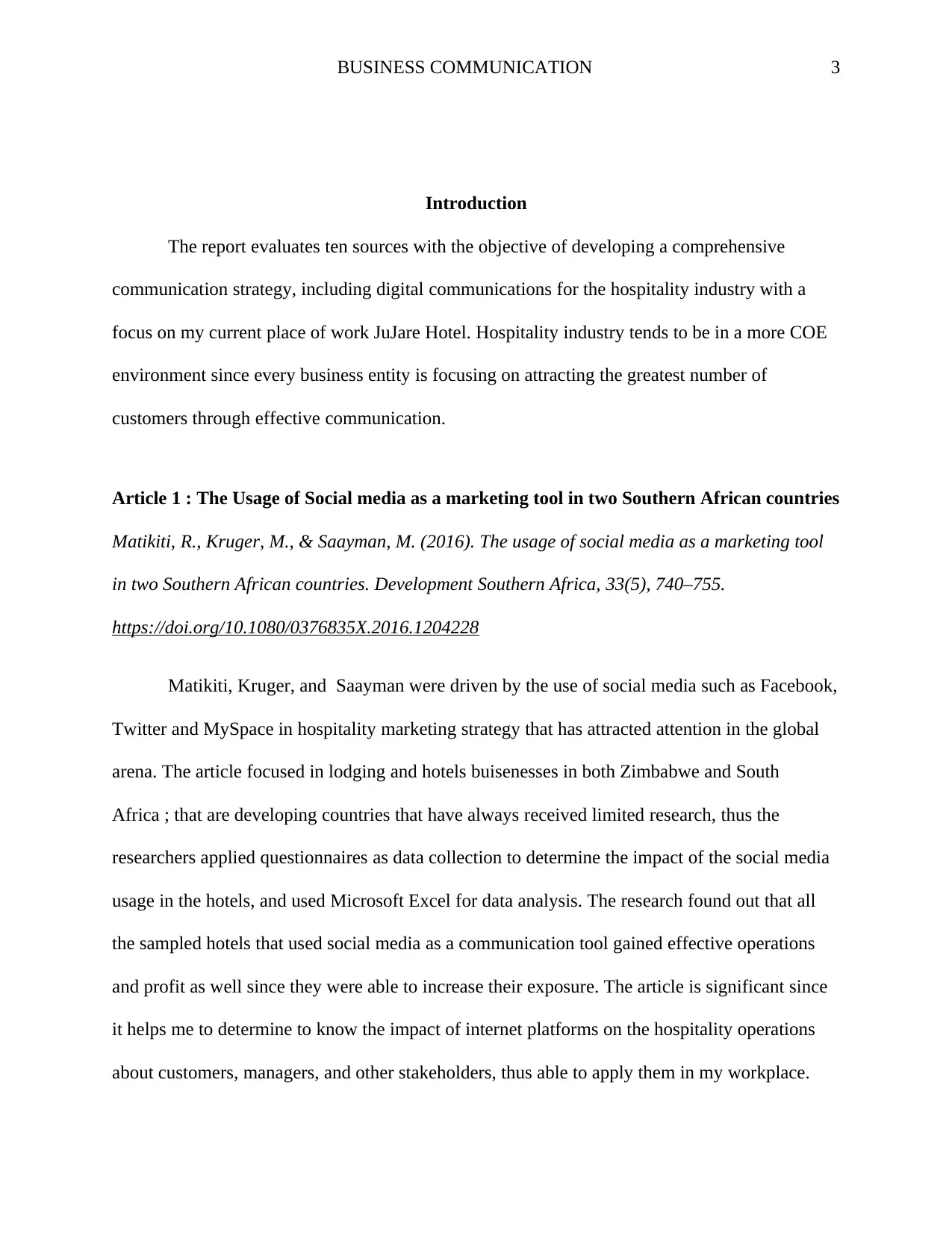
BUSINESS COMMUNICATION 3
Introduction
The report evaluates ten sources with the objective of developing a comprehensive
communication strategy, including digital communications for the hospitality industry with a
focus on my current place of work JuJare Hotel. Hospitality industry tends to be in a more COE
environment since every business entity is focusing on attracting the greatest number of
customers through effective communication.
Article 1 : The Usage of Social media as a marketing tool in two Southern African countries
Matikiti, R., Kruger, M., & Saayman, M. (2016). The usage of social media as a marketing tool
in two Southern African countries. Development Southern Africa, 33(5), 740–755.
https://doi.org/10.1080/0376835X.2016.1204228
Matikiti, Kruger, and Saayman were driven by the use of social media such as Facebook,
Twitter and MySpace in hospitality marketing strategy that has attracted attention in the global
arena. The article focused in lodging and hotels buisenesses in both Zimbabwe and South
Africa ; that are developing countries that have always received limited research, thus the
researchers applied questionnaires as data collection to determine the impact of the social media
usage in the hotels, and used Microsoft Excel for data analysis. The research found out that all
the sampled hotels that used social media as a communication tool gained effective operations
and profit as well since they were able to increase their exposure. The article is significant since
it helps me to determine to know the impact of internet platforms on the hospitality operations
about customers, managers, and other stakeholders, thus able to apply them in my workplace.
Introduction
The report evaluates ten sources with the objective of developing a comprehensive
communication strategy, including digital communications for the hospitality industry with a
focus on my current place of work JuJare Hotel. Hospitality industry tends to be in a more COE
environment since every business entity is focusing on attracting the greatest number of
customers through effective communication.
Article 1 : The Usage of Social media as a marketing tool in two Southern African countries
Matikiti, R., Kruger, M., & Saayman, M. (2016). The usage of social media as a marketing tool
in two Southern African countries. Development Southern Africa, 33(5), 740–755.
https://doi.org/10.1080/0376835X.2016.1204228
Matikiti, Kruger, and Saayman were driven by the use of social media such as Facebook,
Twitter and MySpace in hospitality marketing strategy that has attracted attention in the global
arena. The article focused in lodging and hotels buisenesses in both Zimbabwe and South
Africa ; that are developing countries that have always received limited research, thus the
researchers applied questionnaires as data collection to determine the impact of the social media
usage in the hotels, and used Microsoft Excel for data analysis. The research found out that all
the sampled hotels that used social media as a communication tool gained effective operations
and profit as well since they were able to increase their exposure. The article is significant since
it helps me to determine to know the impact of internet platforms on the hospitality operations
about customers, managers, and other stakeholders, thus able to apply them in my workplace.
⊘ This is a preview!⊘
Do you want full access?
Subscribe today to unlock all pages.

Trusted by 1+ million students worldwide
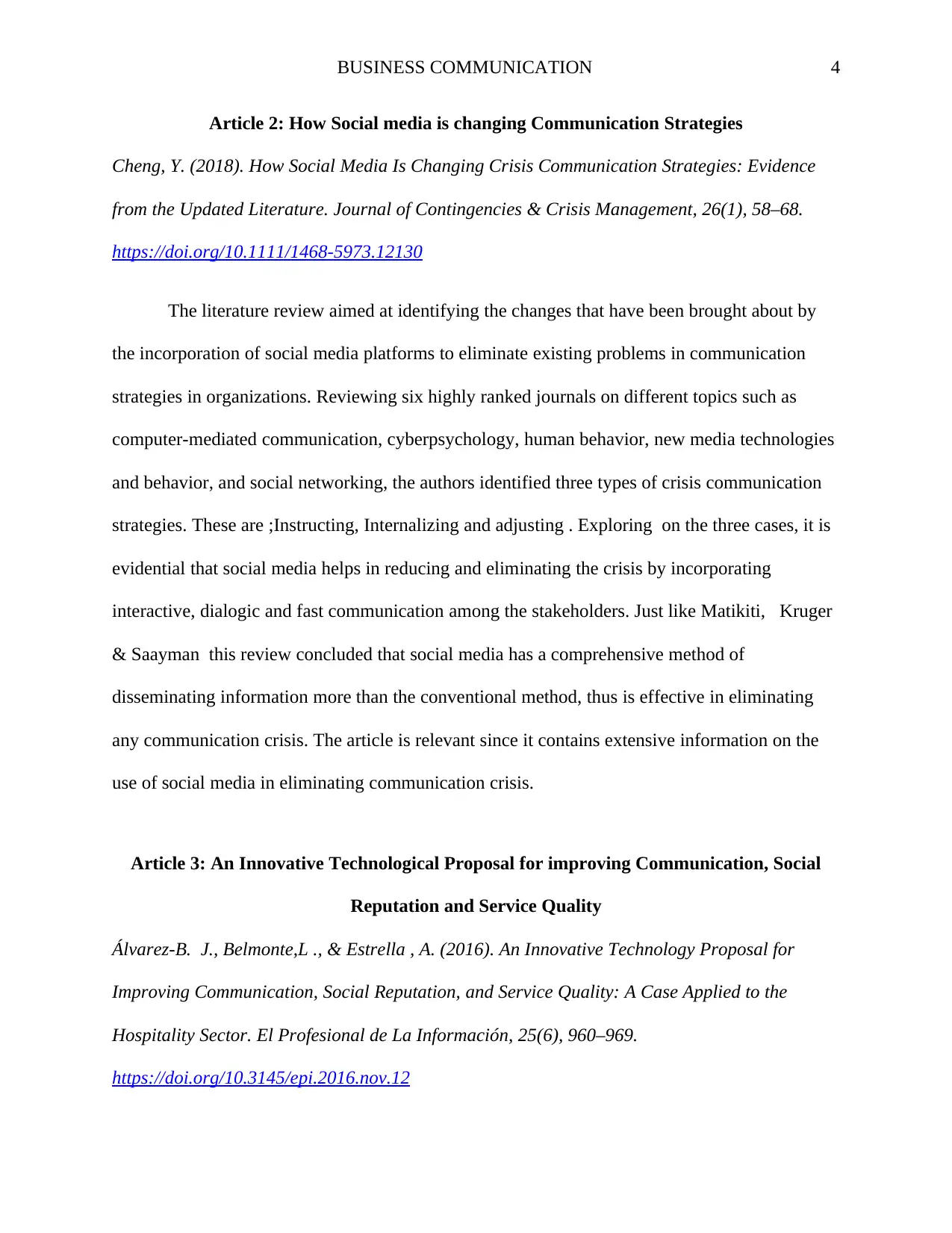
BUSINESS COMMUNICATION 4
Article 2: How Social media is changing Communication Strategies
Cheng, Y. (2018). How Social Media Is Changing Crisis Communication Strategies: Evidence
from the Updated Literature. Journal of Contingencies & Crisis Management, 26(1), 58–68.
https://doi.org/10.1111/1468-5973.12130
The literature review aimed at identifying the changes that have been brought about by
the incorporation of social media platforms to eliminate existing problems in communication
strategies in organizations. Reviewing six highly ranked journals on different topics such as
computer-mediated communication, cyberpsychology, human behavior, new media technologies
and behavior, and social networking, the authors identified three types of crisis communication
strategies. These are ;Instructing, Internalizing and adjusting . Exploring on the three cases, it is
evidential that social media helps in reducing and eliminating the crisis by incorporating
interactive, dialogic and fast communication among the stakeholders. Just like Matikiti, Kruger
& Saayman this review concluded that social media has a comprehensive method of
disseminating information more than the conventional method, thus is effective in eliminating
any communication crisis. The article is relevant since it contains extensive information on the
use of social media in eliminating communication crisis.
Article 3: An Innovative Technological Proposal for improving Communication, Social
Reputation and Service Quality
Álvarez-B. J., Belmonte,L ., & Estrella , A. (2016). An Innovative Technology Proposal for
Improving Communication, Social Reputation, and Service Quality: A Case Applied to the
Hospitality Sector. El Profesional de La Información, 25(6), 960–969.
https://doi.org/10.3145/epi.2016.nov.12
Article 2: How Social media is changing Communication Strategies
Cheng, Y. (2018). How Social Media Is Changing Crisis Communication Strategies: Evidence
from the Updated Literature. Journal of Contingencies & Crisis Management, 26(1), 58–68.
https://doi.org/10.1111/1468-5973.12130
The literature review aimed at identifying the changes that have been brought about by
the incorporation of social media platforms to eliminate existing problems in communication
strategies in organizations. Reviewing six highly ranked journals on different topics such as
computer-mediated communication, cyberpsychology, human behavior, new media technologies
and behavior, and social networking, the authors identified three types of crisis communication
strategies. These are ;Instructing, Internalizing and adjusting . Exploring on the three cases, it is
evidential that social media helps in reducing and eliminating the crisis by incorporating
interactive, dialogic and fast communication among the stakeholders. Just like Matikiti, Kruger
& Saayman this review concluded that social media has a comprehensive method of
disseminating information more than the conventional method, thus is effective in eliminating
any communication crisis. The article is relevant since it contains extensive information on the
use of social media in eliminating communication crisis.
Article 3: An Innovative Technological Proposal for improving Communication, Social
Reputation and Service Quality
Álvarez-B. J., Belmonte,L ., & Estrella , A. (2016). An Innovative Technology Proposal for
Improving Communication, Social Reputation, and Service Quality: A Case Applied to the
Hospitality Sector. El Profesional de La Información, 25(6), 960–969.
https://doi.org/10.3145/epi.2016.nov.12
Paraphrase This Document
Need a fresh take? Get an instant paraphrase of this document with our AI Paraphraser
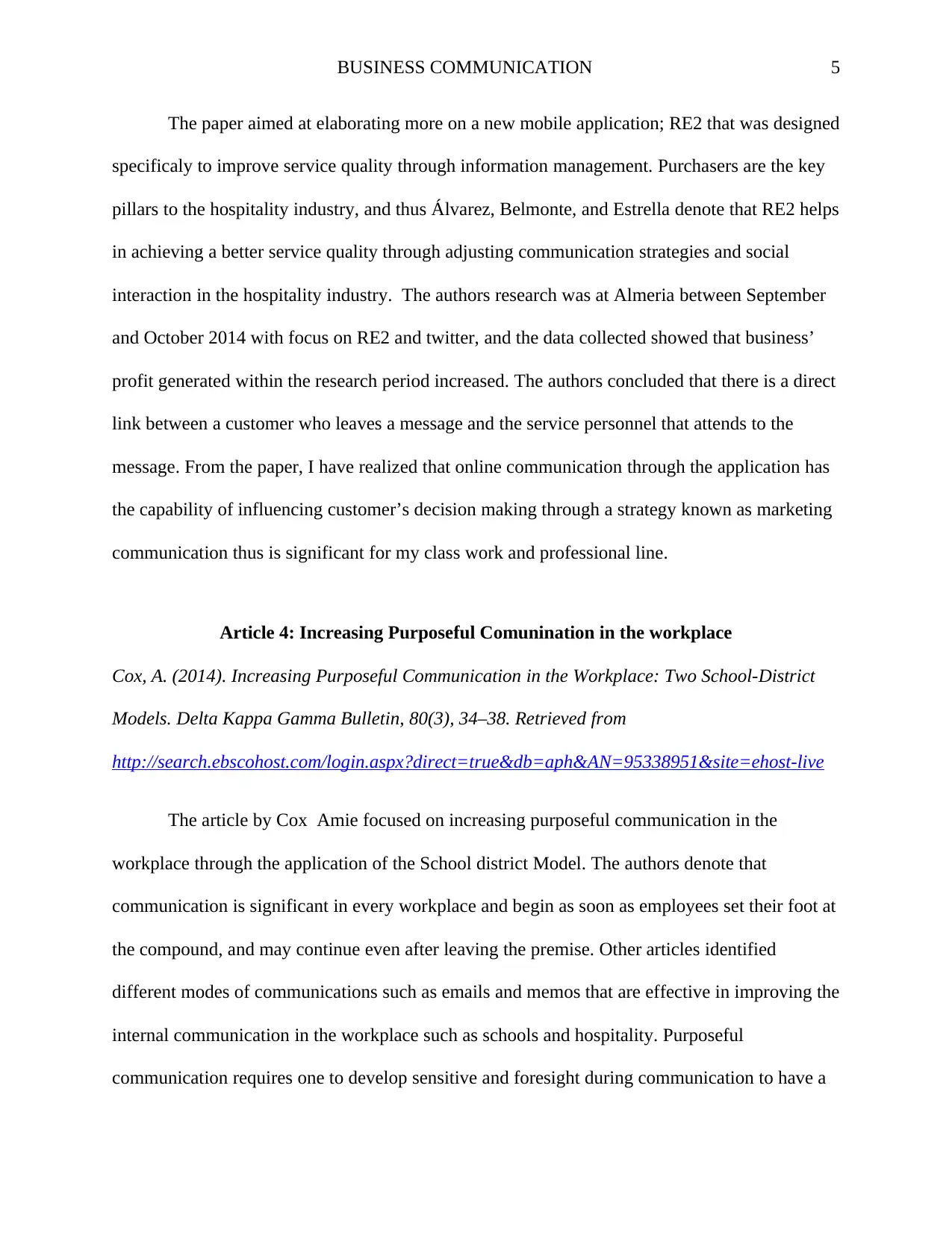
BUSINESS COMMUNICATION 5
The paper aimed at elaborating more on a new mobile application; RE2 that was designed
specificaly to improve service quality through information management. Purchasers are the key
pillars to the hospitality industry, and thus Álvarez, Belmonte, and Estrella denote that RE2 helps
in achieving a better service quality through adjusting communication strategies and social
interaction in the hospitality industry. The authors research was at Almeria between September
and October 2014 with focus on RE2 and twitter, and the data collected showed that business’
profit generated within the research period increased. The authors concluded that there is a direct
link between a customer who leaves a message and the service personnel that attends to the
message. From the paper, I have realized that online communication through the application has
the capability of influencing customer’s decision making through a strategy known as marketing
communication thus is significant for my class work and professional line.
Article 4: Increasing Purposeful Comunination in the workplace
Cox, A. (2014). Increasing Purposeful Communication in the Workplace: Two School-District
Models. Delta Kappa Gamma Bulletin, 80(3), 34–38. Retrieved from
http://search.ebscohost.com/login.aspx?direct=true&db=aph&AN=95338951&site=ehost-live
The article by Cox Amie focused on increasing purposeful communication in the
workplace through the application of the School district Model. The authors denote that
communication is significant in every workplace and begin as soon as employees set their foot at
the compound, and may continue even after leaving the premise. Other articles identified
different modes of communications such as emails and memos that are effective in improving the
internal communication in the workplace such as schools and hospitality. Purposeful
communication requires one to develop sensitive and foresight during communication to have a
The paper aimed at elaborating more on a new mobile application; RE2 that was designed
specificaly to improve service quality through information management. Purchasers are the key
pillars to the hospitality industry, and thus Álvarez, Belmonte, and Estrella denote that RE2 helps
in achieving a better service quality through adjusting communication strategies and social
interaction in the hospitality industry. The authors research was at Almeria between September
and October 2014 with focus on RE2 and twitter, and the data collected showed that business’
profit generated within the research period increased. The authors concluded that there is a direct
link between a customer who leaves a message and the service personnel that attends to the
message. From the paper, I have realized that online communication through the application has
the capability of influencing customer’s decision making through a strategy known as marketing
communication thus is significant for my class work and professional line.
Article 4: Increasing Purposeful Comunination in the workplace
Cox, A. (2014). Increasing Purposeful Communication in the Workplace: Two School-District
Models. Delta Kappa Gamma Bulletin, 80(3), 34–38. Retrieved from
http://search.ebscohost.com/login.aspx?direct=true&db=aph&AN=95338951&site=ehost-live
The article by Cox Amie focused on increasing purposeful communication in the
workplace through the application of the School district Model. The authors denote that
communication is significant in every workplace and begin as soon as employees set their foot at
the compound, and may continue even after leaving the premise. Other articles identified
different modes of communications such as emails and memos that are effective in improving the
internal communication in the workplace such as schools and hospitality. Purposeful
communication requires one to develop sensitive and foresight during communication to have a
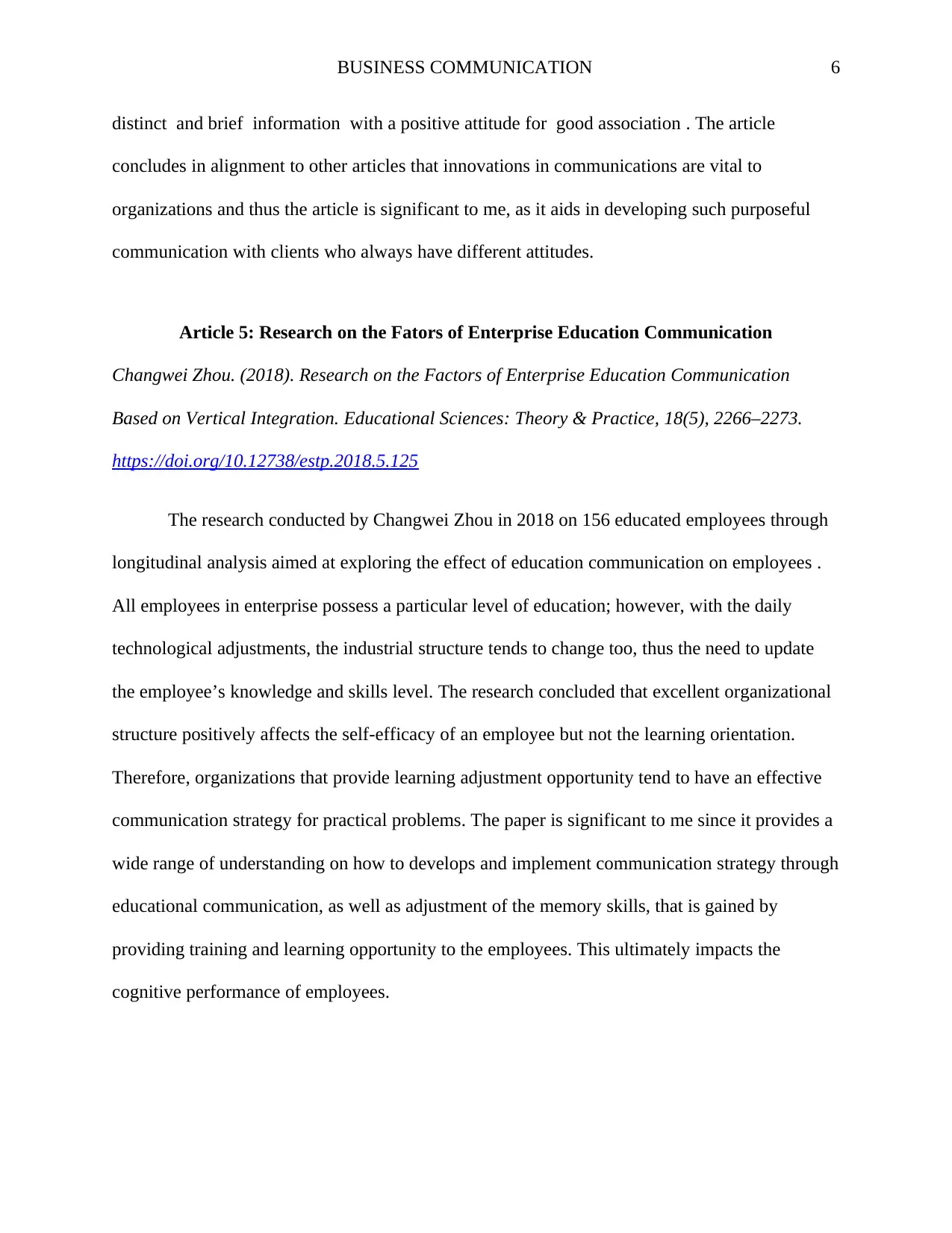
BUSINESS COMMUNICATION 6
distinct and brief information with a positive attitude for good association . The article
concludes in alignment to other articles that innovations in communications are vital to
organizations and thus the article is significant to me, as it aids in developing such purposeful
communication with clients who always have different attitudes.
Article 5: Research on the Fators of Enterprise Education Communication
Changwei Zhou. (2018). Research on the Factors of Enterprise Education Communication
Based on Vertical Integration. Educational Sciences: Theory & Practice, 18(5), 2266–2273.
https://doi.org/10.12738/estp.2018.5.125
The research conducted by Changwei Zhou in 2018 on 156 educated employees through
longitudinal analysis aimed at exploring the effect of education communication on employees .
All employees in enterprise possess a particular level of education; however, with the daily
technological adjustments, the industrial structure tends to change too, thus the need to update
the employee’s knowledge and skills level. The research concluded that excellent organizational
structure positively affects the self-efficacy of an employee but not the learning orientation.
Therefore, organizations that provide learning adjustment opportunity tend to have an effective
communication strategy for practical problems. The paper is significant to me since it provides a
wide range of understanding on how to develops and implement communication strategy through
educational communication, as well as adjustment of the memory skills, that is gained by
providing training and learning opportunity to the employees. This ultimately impacts the
cognitive performance of employees.
distinct and brief information with a positive attitude for good association . The article
concludes in alignment to other articles that innovations in communications are vital to
organizations and thus the article is significant to me, as it aids in developing such purposeful
communication with clients who always have different attitudes.
Article 5: Research on the Fators of Enterprise Education Communication
Changwei Zhou. (2018). Research on the Factors of Enterprise Education Communication
Based on Vertical Integration. Educational Sciences: Theory & Practice, 18(5), 2266–2273.
https://doi.org/10.12738/estp.2018.5.125
The research conducted by Changwei Zhou in 2018 on 156 educated employees through
longitudinal analysis aimed at exploring the effect of education communication on employees .
All employees in enterprise possess a particular level of education; however, with the daily
technological adjustments, the industrial structure tends to change too, thus the need to update
the employee’s knowledge and skills level. The research concluded that excellent organizational
structure positively affects the self-efficacy of an employee but not the learning orientation.
Therefore, organizations that provide learning adjustment opportunity tend to have an effective
communication strategy for practical problems. The paper is significant to me since it provides a
wide range of understanding on how to develops and implement communication strategy through
educational communication, as well as adjustment of the memory skills, that is gained by
providing training and learning opportunity to the employees. This ultimately impacts the
cognitive performance of employees.
⊘ This is a preview!⊘
Do you want full access?
Subscribe today to unlock all pages.

Trusted by 1+ million students worldwide
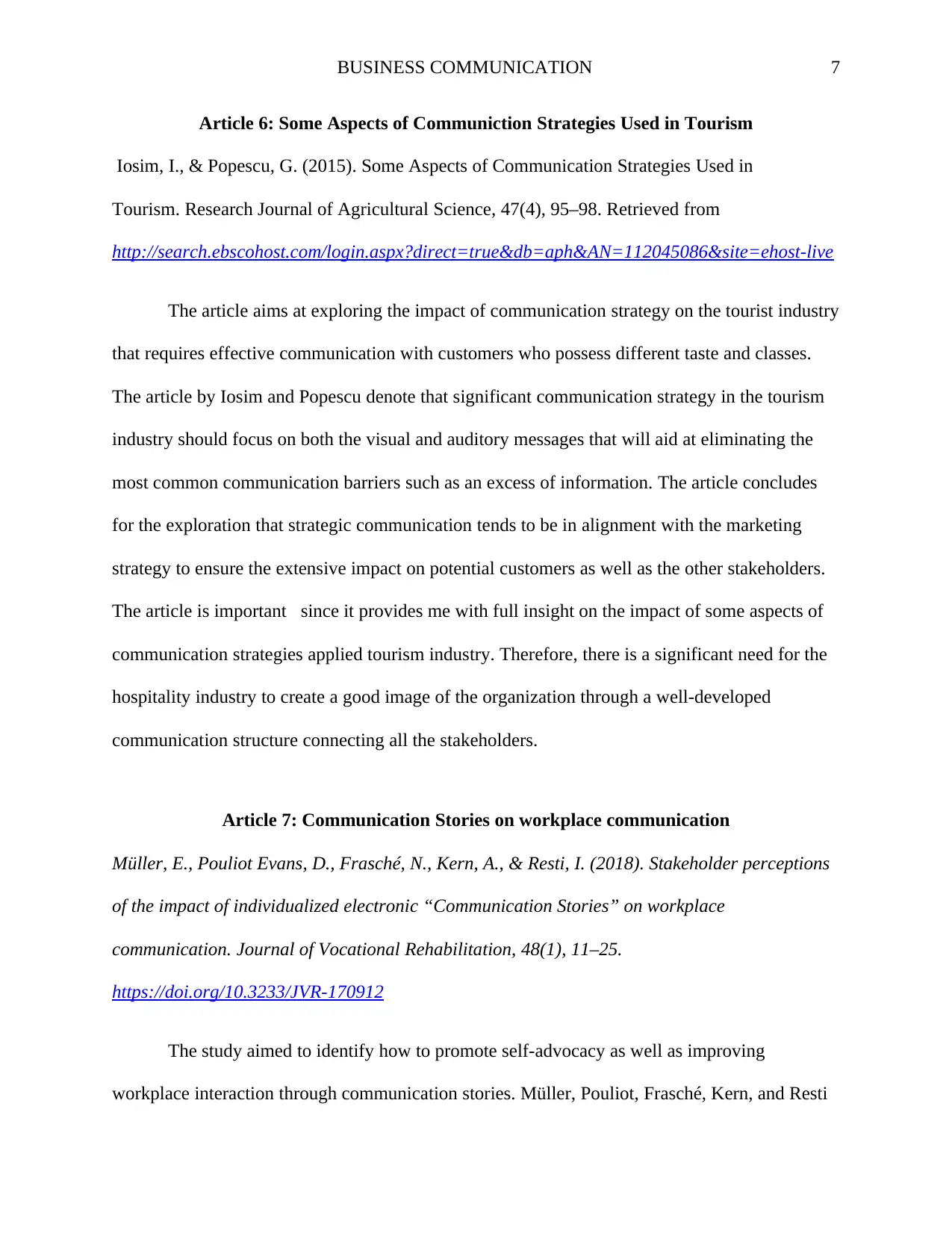
BUSINESS COMMUNICATION 7
Article 6: Some Aspects of Communiction Strategies Used in Tourism
Iosim, I., & Popescu, G. (2015). Some Aspects of Communication Strategies Used in
Tourism. Research Journal of Agricultural Science, 47(4), 95–98. Retrieved from
http://search.ebscohost.com/login.aspx?direct=true&db=aph&AN=112045086&site=ehost-live
The article aims at exploring the impact of communication strategy on the tourist industry
that requires effective communication with customers who possess different taste and classes.
The article by Iosim and Popescu denote that significant communication strategy in the tourism
industry should focus on both the visual and auditory messages that will aid at eliminating the
most common communication barriers such as an excess of information. The article concludes
for the exploration that strategic communication tends to be in alignment with the marketing
strategy to ensure the extensive impact on potential customers as well as the other stakeholders.
The article is important since it provides me with full insight on the impact of some aspects of
communication strategies applied tourism industry. Therefore, there is a significant need for the
hospitality industry to create a good image of the organization through a well-developed
communication structure connecting all the stakeholders.
Article 7: Communication Stories on workplace communication
Müller, E., Pouliot Evans, D., Frasché, N., Kern, A., & Resti, I. (2018). Stakeholder perceptions
of the impact of individualized electronic “Communication Stories” on workplace
communication. Journal of Vocational Rehabilitation, 48(1), 11–25.
https://doi.org/10.3233/JVR-170912
The study aimed to identify how to promote self-advocacy as well as improving
workplace interaction through communication stories. Müller, Pouliot, Frasché, Kern, and Resti
Article 6: Some Aspects of Communiction Strategies Used in Tourism
Iosim, I., & Popescu, G. (2015). Some Aspects of Communication Strategies Used in
Tourism. Research Journal of Agricultural Science, 47(4), 95–98. Retrieved from
http://search.ebscohost.com/login.aspx?direct=true&db=aph&AN=112045086&site=ehost-live
The article aims at exploring the impact of communication strategy on the tourist industry
that requires effective communication with customers who possess different taste and classes.
The article by Iosim and Popescu denote that significant communication strategy in the tourism
industry should focus on both the visual and auditory messages that will aid at eliminating the
most common communication barriers such as an excess of information. The article concludes
for the exploration that strategic communication tends to be in alignment with the marketing
strategy to ensure the extensive impact on potential customers as well as the other stakeholders.
The article is important since it provides me with full insight on the impact of some aspects of
communication strategies applied tourism industry. Therefore, there is a significant need for the
hospitality industry to create a good image of the organization through a well-developed
communication structure connecting all the stakeholders.
Article 7: Communication Stories on workplace communication
Müller, E., Pouliot Evans, D., Frasché, N., Kern, A., & Resti, I. (2018). Stakeholder perceptions
of the impact of individualized electronic “Communication Stories” on workplace
communication. Journal of Vocational Rehabilitation, 48(1), 11–25.
https://doi.org/10.3233/JVR-170912
The study aimed to identify how to promote self-advocacy as well as improving
workplace interaction through communication stories. Müller, Pouliot, Frasché, Kern, and Resti
Paraphrase This Document
Need a fresh take? Get an instant paraphrase of this document with our AI Paraphraser
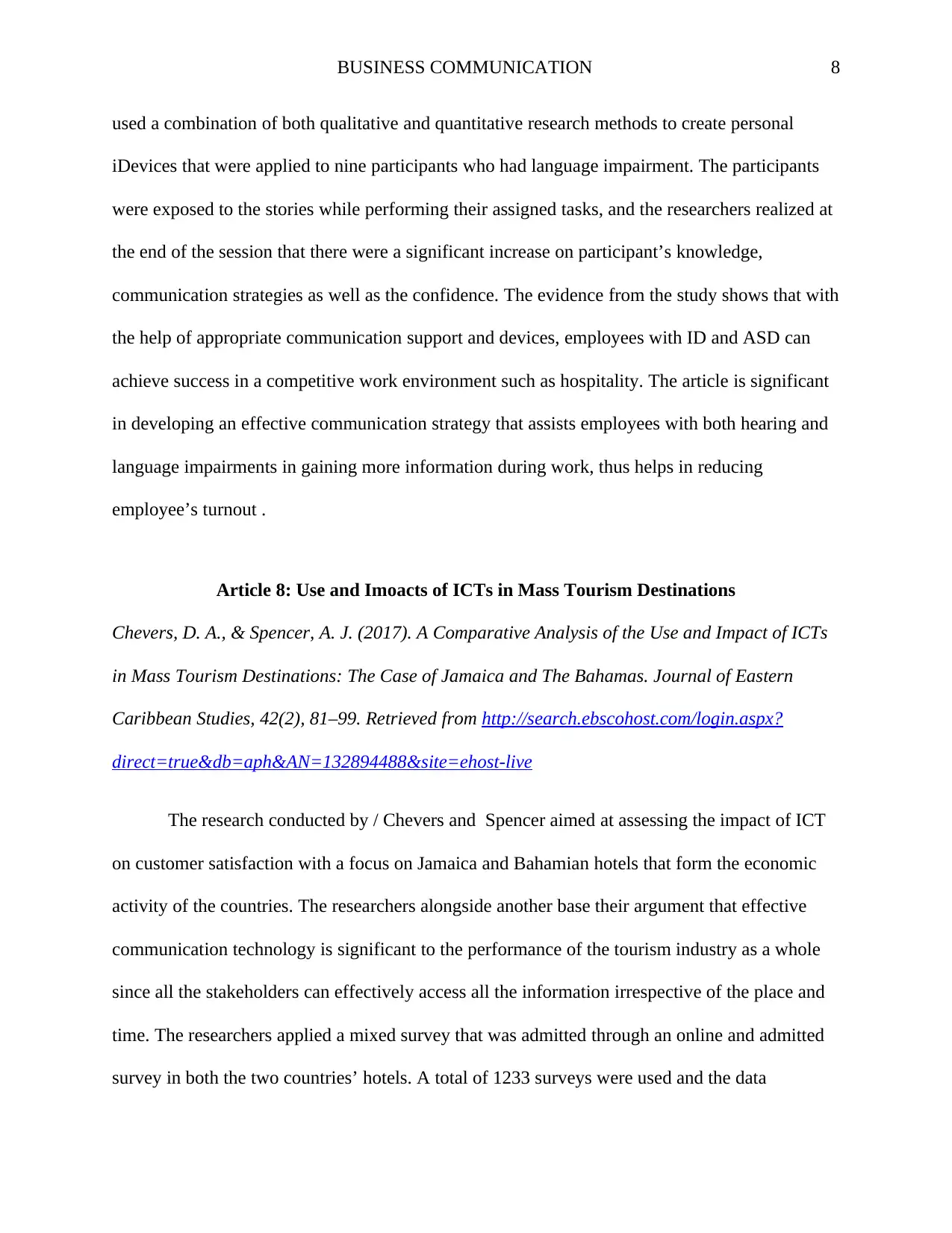
BUSINESS COMMUNICATION 8
used a combination of both qualitative and quantitative research methods to create personal
iDevices that were applied to nine participants who had language impairment. The participants
were exposed to the stories while performing their assigned tasks, and the researchers realized at
the end of the session that there were a significant increase on participant’s knowledge,
communication strategies as well as the confidence. The evidence from the study shows that with
the help of appropriate communication support and devices, employees with ID and ASD can
achieve success in a competitive work environment such as hospitality. The article is significant
in developing an effective communication strategy that assists employees with both hearing and
language impairments in gaining more information during work, thus helps in reducing
employee’s turnout .
Article 8: Use and Imoacts of ICTs in Mass Tourism Destinations
Chevers, D. A., & Spencer, A. J. (2017). A Comparative Analysis of the Use and Impact of ICTs
in Mass Tourism Destinations: The Case of Jamaica and The Bahamas. Journal of Eastern
Caribbean Studies, 42(2), 81–99. Retrieved from http://search.ebscohost.com/login.aspx?
direct=true&db=aph&AN=132894488&site=ehost-live
The research conducted by / Chevers and Spencer aimed at assessing the impact of ICT
on customer satisfaction with a focus on Jamaica and Bahamian hotels that form the economic
activity of the countries. The researchers alongside another base their argument that effective
communication technology is significant to the performance of the tourism industry as a whole
since all the stakeholders can effectively access all the information irrespective of the place and
time. The researchers applied a mixed survey that was admitted through an online and admitted
survey in both the two countries’ hotels. A total of 1233 surveys were used and the data
used a combination of both qualitative and quantitative research methods to create personal
iDevices that were applied to nine participants who had language impairment. The participants
were exposed to the stories while performing their assigned tasks, and the researchers realized at
the end of the session that there were a significant increase on participant’s knowledge,
communication strategies as well as the confidence. The evidence from the study shows that with
the help of appropriate communication support and devices, employees with ID and ASD can
achieve success in a competitive work environment such as hospitality. The article is significant
in developing an effective communication strategy that assists employees with both hearing and
language impairments in gaining more information during work, thus helps in reducing
employee’s turnout .
Article 8: Use and Imoacts of ICTs in Mass Tourism Destinations
Chevers, D. A., & Spencer, A. J. (2017). A Comparative Analysis of the Use and Impact of ICTs
in Mass Tourism Destinations: The Case of Jamaica and The Bahamas. Journal of Eastern
Caribbean Studies, 42(2), 81–99. Retrieved from http://search.ebscohost.com/login.aspx?
direct=true&db=aph&AN=132894488&site=ehost-live
The research conducted by / Chevers and Spencer aimed at assessing the impact of ICT
on customer satisfaction with a focus on Jamaica and Bahamian hotels that form the economic
activity of the countries. The researchers alongside another base their argument that effective
communication technology is significant to the performance of the tourism industry as a whole
since all the stakeholders can effectively access all the information irrespective of the place and
time. The researchers applied a mixed survey that was admitted through an online and admitted
survey in both the two countries’ hotels. A total of 1233 surveys were used and the data
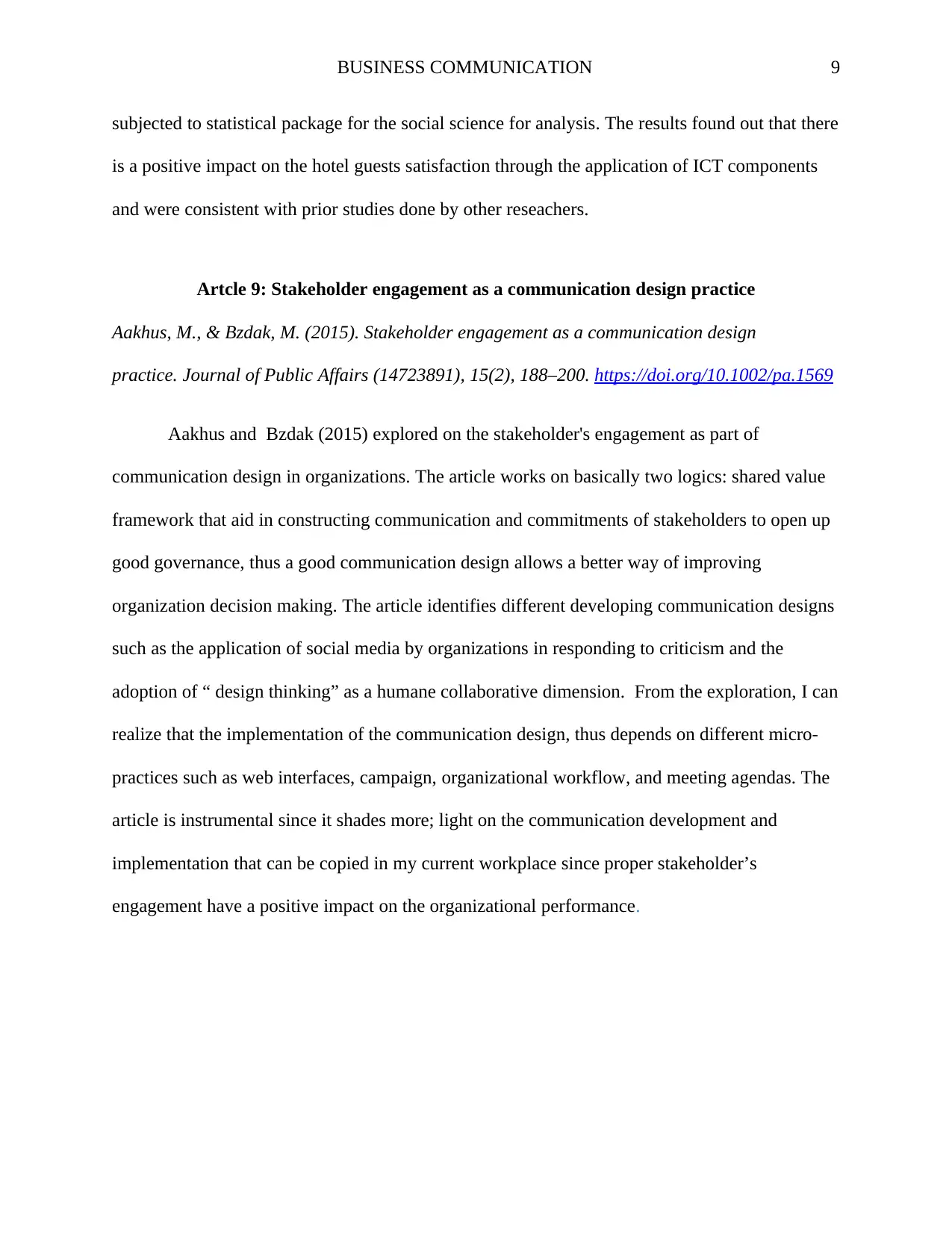
BUSINESS COMMUNICATION 9
subjected to statistical package for the social science for analysis. The results found out that there
is a positive impact on the hotel guests satisfaction through the application of ICT components
and were consistent with prior studies done by other reseachers.
Artcle 9: Stakeholder engagement as a communication design practice
Aakhus, M., & Bzdak, M. (2015). Stakeholder engagement as a communication design
practice. Journal of Public Affairs (14723891), 15(2), 188–200. https://doi.org/10.1002/pa.1569
Aakhus and Bzdak (2015) explored on the stakeholder's engagement as part of
communication design in organizations. The article works on basically two logics: shared value
framework that aid in constructing communication and commitments of stakeholders to open up
good governance, thus a good communication design allows a better way of improving
organization decision making. The article identifies different developing communication designs
such as the application of social media by organizations in responding to criticism and the
adoption of “ design thinking” as a humane collaborative dimension. From the exploration, I can
realize that the implementation of the communication design, thus depends on different micro-
practices such as web interfaces, campaign, organizational workflow, and meeting agendas. The
article is instrumental since it shades more; light on the communication development and
implementation that can be copied in my current workplace since proper stakeholder’s
engagement have a positive impact on the organizational performance.
subjected to statistical package for the social science for analysis. The results found out that there
is a positive impact on the hotel guests satisfaction through the application of ICT components
and were consistent with prior studies done by other reseachers.
Artcle 9: Stakeholder engagement as a communication design practice
Aakhus, M., & Bzdak, M. (2015). Stakeholder engagement as a communication design
practice. Journal of Public Affairs (14723891), 15(2), 188–200. https://doi.org/10.1002/pa.1569
Aakhus and Bzdak (2015) explored on the stakeholder's engagement as part of
communication design in organizations. The article works on basically two logics: shared value
framework that aid in constructing communication and commitments of stakeholders to open up
good governance, thus a good communication design allows a better way of improving
organization decision making. The article identifies different developing communication designs
such as the application of social media by organizations in responding to criticism and the
adoption of “ design thinking” as a humane collaborative dimension. From the exploration, I can
realize that the implementation of the communication design, thus depends on different micro-
practices such as web interfaces, campaign, organizational workflow, and meeting agendas. The
article is instrumental since it shades more; light on the communication development and
implementation that can be copied in my current workplace since proper stakeholder’s
engagement have a positive impact on the organizational performance.
⊘ This is a preview!⊘
Do you want full access?
Subscribe today to unlock all pages.

Trusted by 1+ million students worldwide
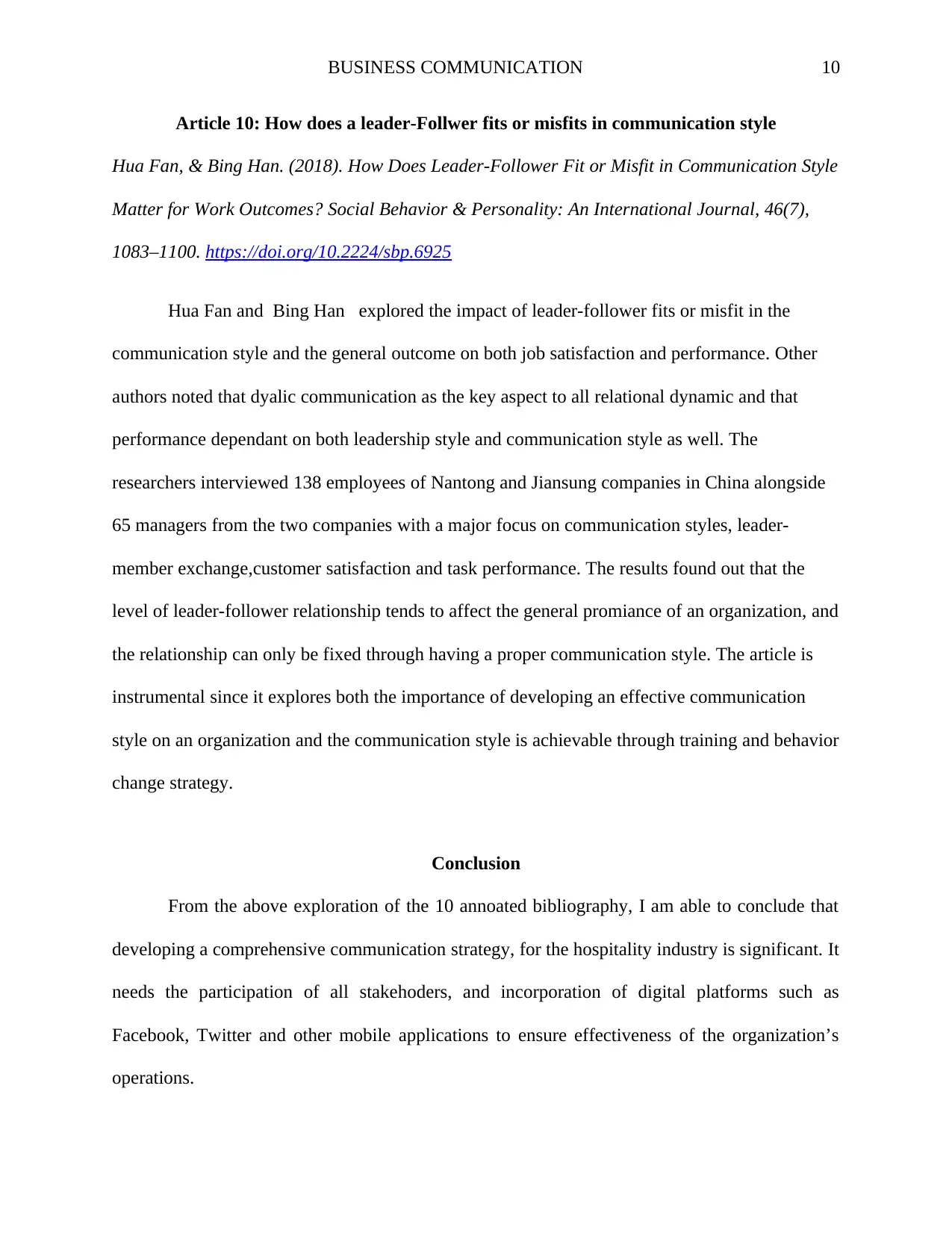
BUSINESS COMMUNICATION 10
Article 10: How does a leader-Follwer fits or misfits in communication style
Hua Fan, & Bing Han. (2018). How Does Leader-Follower Fit or Misfit in Communication Style
Matter for Work Outcomes? Social Behavior & Personality: An International Journal, 46(7),
1083–1100. https://doi.org/10.2224/sbp.6925
Hua Fan and Bing Han explored the impact of leader-follower fits or misfit in the
communication style and the general outcome on both job satisfaction and performance. Other
authors noted that dyalic communication as the key aspect to all relational dynamic and that
performance dependant on both leadership style and communication style as well. The
researchers interviewed 138 employees of Nantong and Jiansung companies in China alongside
65 managers from the two companies with a major focus on communication styles, leader-
member exchange,customer satisfaction and task performance. The results found out that the
level of leader-follower relationship tends to affect the general promiance of an organization, and
the relationship can only be fixed through having a proper communication style. The article is
instrumental since it explores both the importance of developing an effective communication
style on an organization and the communication style is achievable through training and behavior
change strategy.
Conclusion
From the above exploration of the 10 annoated bibliography, I am able to conclude that
developing a comprehensive communication strategy, for the hospitality industry is significant. It
needs the participation of all stakehoders, and incorporation of digital platforms such as
Facebook, Twitter and other mobile applications to ensure effectiveness of the organization’s
operations.
Article 10: How does a leader-Follwer fits or misfits in communication style
Hua Fan, & Bing Han. (2018). How Does Leader-Follower Fit or Misfit in Communication Style
Matter for Work Outcomes? Social Behavior & Personality: An International Journal, 46(7),
1083–1100. https://doi.org/10.2224/sbp.6925
Hua Fan and Bing Han explored the impact of leader-follower fits or misfit in the
communication style and the general outcome on both job satisfaction and performance. Other
authors noted that dyalic communication as the key aspect to all relational dynamic and that
performance dependant on both leadership style and communication style as well. The
researchers interviewed 138 employees of Nantong and Jiansung companies in China alongside
65 managers from the two companies with a major focus on communication styles, leader-
member exchange,customer satisfaction and task performance. The results found out that the
level of leader-follower relationship tends to affect the general promiance of an organization, and
the relationship can only be fixed through having a proper communication style. The article is
instrumental since it explores both the importance of developing an effective communication
style on an organization and the communication style is achievable through training and behavior
change strategy.
Conclusion
From the above exploration of the 10 annoated bibliography, I am able to conclude that
developing a comprehensive communication strategy, for the hospitality industry is significant. It
needs the participation of all stakehoders, and incorporation of digital platforms such as
Facebook, Twitter and other mobile applications to ensure effectiveness of the organization’s
operations.
Paraphrase This Document
Need a fresh take? Get an instant paraphrase of this document with our AI Paraphraser
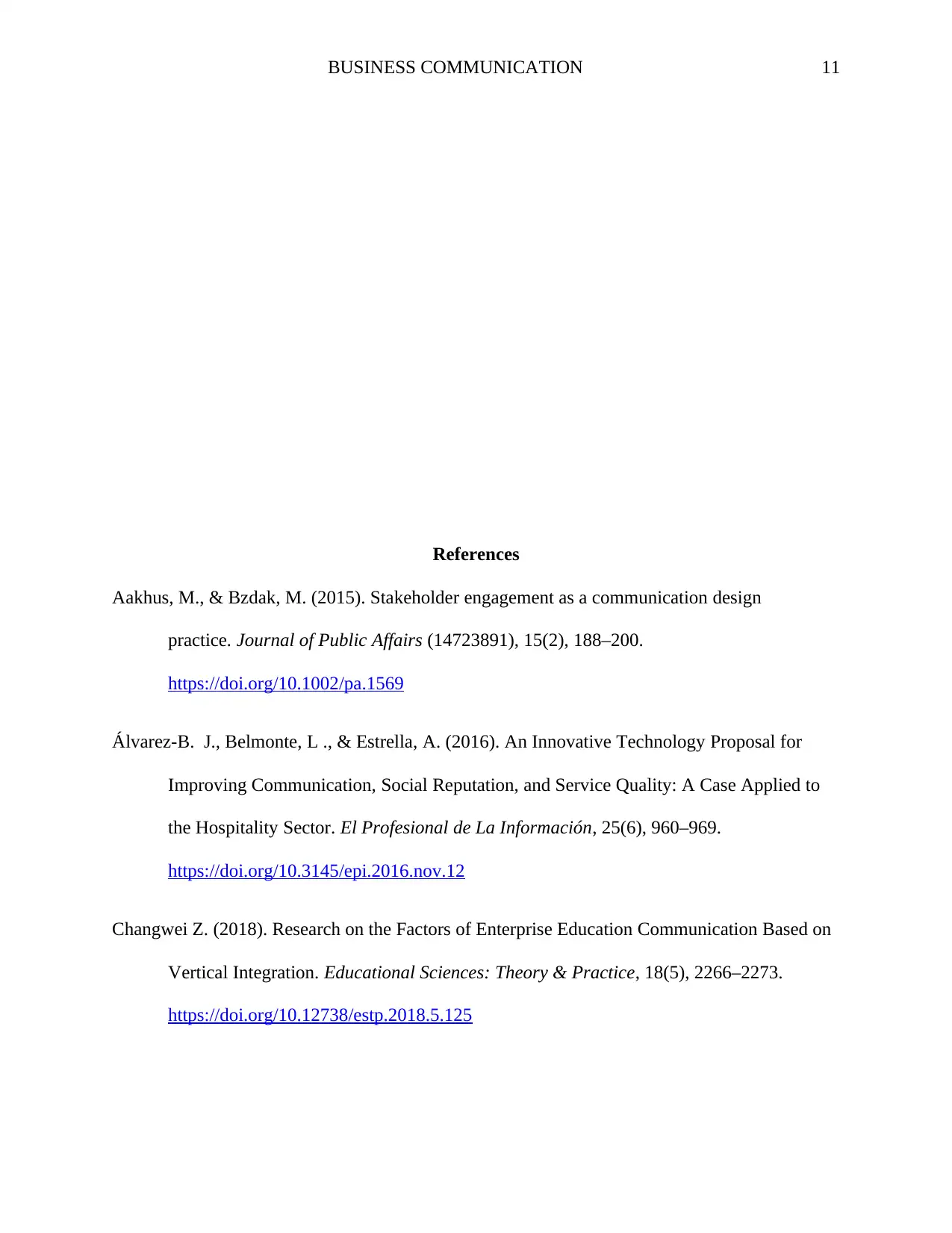
BUSINESS COMMUNICATION 11
References
Aakhus, M., & Bzdak, M. (2015). Stakeholder engagement as a communication design
practice. Journal of Public Affairs (14723891), 15(2), 188–200.
https://doi.org/10.1002/pa.1569
Álvarez-B. J., Belmonte, L ., & Estrella, A. (2016). An Innovative Technology Proposal for
Improving Communication, Social Reputation, and Service Quality: A Case Applied to
the Hospitality Sector. El Profesional de La Información, 25(6), 960–969.
https://doi.org/10.3145/epi.2016.nov.12
Changwei Z. (2018). Research on the Factors of Enterprise Education Communication Based on
Vertical Integration. Educational Sciences: Theory & Practice, 18(5), 2266–2273.
https://doi.org/10.12738/estp.2018.5.125
References
Aakhus, M., & Bzdak, M. (2015). Stakeholder engagement as a communication design
practice. Journal of Public Affairs (14723891), 15(2), 188–200.
https://doi.org/10.1002/pa.1569
Álvarez-B. J., Belmonte, L ., & Estrella, A. (2016). An Innovative Technology Proposal for
Improving Communication, Social Reputation, and Service Quality: A Case Applied to
the Hospitality Sector. El Profesional de La Información, 25(6), 960–969.
https://doi.org/10.3145/epi.2016.nov.12
Changwei Z. (2018). Research on the Factors of Enterprise Education Communication Based on
Vertical Integration. Educational Sciences: Theory & Practice, 18(5), 2266–2273.
https://doi.org/10.12738/estp.2018.5.125
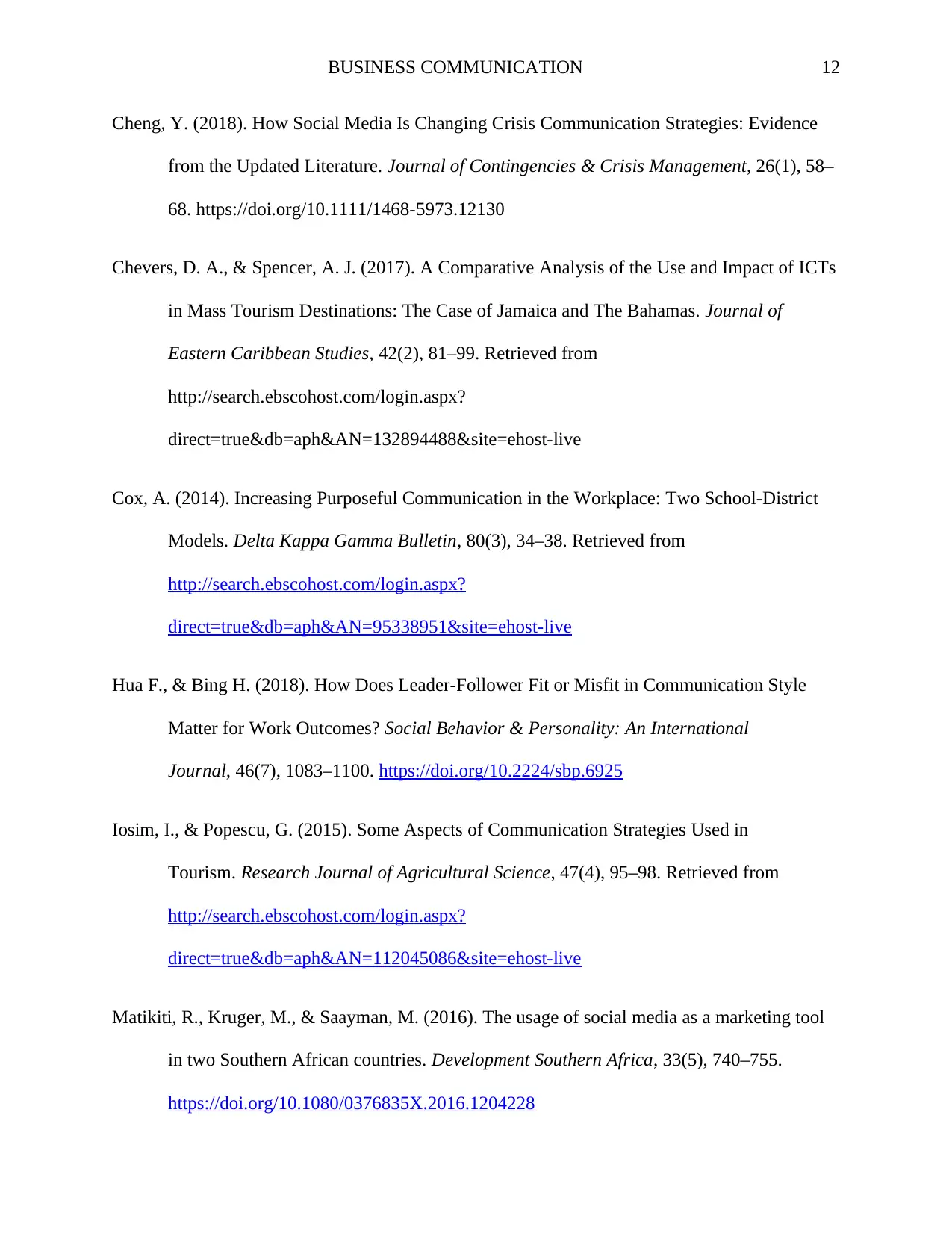
BUSINESS COMMUNICATION 12
Cheng, Y. (2018). How Social Media Is Changing Crisis Communication Strategies: Evidence
from the Updated Literature. Journal of Contingencies & Crisis Management, 26(1), 58–
68. https://doi.org/10.1111/1468-5973.12130
Chevers, D. A., & Spencer, A. J. (2017). A Comparative Analysis of the Use and Impact of ICTs
in Mass Tourism Destinations: The Case of Jamaica and The Bahamas. Journal of
Eastern Caribbean Studies, 42(2), 81–99. Retrieved from
http://search.ebscohost.com/login.aspx?
direct=true&db=aph&AN=132894488&site=ehost-live
Cox, A. (2014). Increasing Purposeful Communication in the Workplace: Two School-District
Models. Delta Kappa Gamma Bulletin, 80(3), 34–38. Retrieved from
http://search.ebscohost.com/login.aspx?
direct=true&db=aph&AN=95338951&site=ehost-live
Hua F., & Bing H. (2018). How Does Leader-Follower Fit or Misfit in Communication Style
Matter for Work Outcomes? Social Behavior & Personality: An International
Journal, 46(7), 1083–1100. https://doi.org/10.2224/sbp.6925
Iosim, I., & Popescu, G. (2015). Some Aspects of Communication Strategies Used in
Tourism. Research Journal of Agricultural Science, 47(4), 95–98. Retrieved from
http://search.ebscohost.com/login.aspx?
direct=true&db=aph&AN=112045086&site=ehost-live
Matikiti, R., Kruger, M., & Saayman, M. (2016). The usage of social media as a marketing tool
in two Southern African countries. Development Southern Africa, 33(5), 740–755.
https://doi.org/10.1080/0376835X.2016.1204228
Cheng, Y. (2018). How Social Media Is Changing Crisis Communication Strategies: Evidence
from the Updated Literature. Journal of Contingencies & Crisis Management, 26(1), 58–
68. https://doi.org/10.1111/1468-5973.12130
Chevers, D. A., & Spencer, A. J. (2017). A Comparative Analysis of the Use and Impact of ICTs
in Mass Tourism Destinations: The Case of Jamaica and The Bahamas. Journal of
Eastern Caribbean Studies, 42(2), 81–99. Retrieved from
http://search.ebscohost.com/login.aspx?
direct=true&db=aph&AN=132894488&site=ehost-live
Cox, A. (2014). Increasing Purposeful Communication in the Workplace: Two School-District
Models. Delta Kappa Gamma Bulletin, 80(3), 34–38. Retrieved from
http://search.ebscohost.com/login.aspx?
direct=true&db=aph&AN=95338951&site=ehost-live
Hua F., & Bing H. (2018). How Does Leader-Follower Fit or Misfit in Communication Style
Matter for Work Outcomes? Social Behavior & Personality: An International
Journal, 46(7), 1083–1100. https://doi.org/10.2224/sbp.6925
Iosim, I., & Popescu, G. (2015). Some Aspects of Communication Strategies Used in
Tourism. Research Journal of Agricultural Science, 47(4), 95–98. Retrieved from
http://search.ebscohost.com/login.aspx?
direct=true&db=aph&AN=112045086&site=ehost-live
Matikiti, R., Kruger, M., & Saayman, M. (2016). The usage of social media as a marketing tool
in two Southern African countries. Development Southern Africa, 33(5), 740–755.
https://doi.org/10.1080/0376835X.2016.1204228
⊘ This is a preview!⊘
Do you want full access?
Subscribe today to unlock all pages.

Trusted by 1+ million students worldwide
1 out of 13
Related Documents
Your All-in-One AI-Powered Toolkit for Academic Success.
+13062052269
info@desklib.com
Available 24*7 on WhatsApp / Email
![[object Object]](/_next/static/media/star-bottom.7253800d.svg)
Unlock your academic potential
Copyright © 2020–2025 A2Z Services. All Rights Reserved. Developed and managed by ZUCOL.




